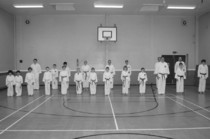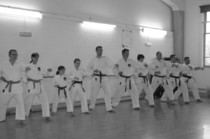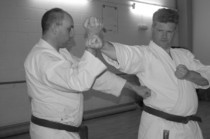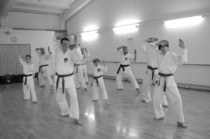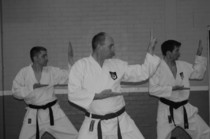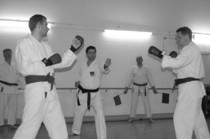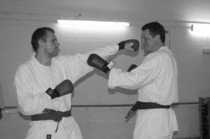
Where to find us?
To find out more details contact Nick (details in About Us Section)
St Pauls Church
Tuesday night Beginners Seniors & Juniors 13+ any grade
6pm-7.30pm
Gym Fit
Friday night
Advanced Class
Orange belts and above; Seniors & Juniors 13+
6pm-7.30pm
£5 TWK Member
£10 Non Member
Addresses :
Tuesday Night
St Pauls Church
Church Road
Clacton-on-Sea
Follow us on Facebook
https://en-gb.facebook.com/pg/TendringWadoKai
Friday Night
Gym Fit
27 Holland Road,
Clacton-on-Sea, Essex
Find us :
https://en-gb.facebook.com/gymfitclacton/
Courses & Tournaments
The next courses and gradings:
Saturday 5th July Clacton - BWKS Summer Course & Dan Grading
Saturday 4th October Lenwood - BWKS Championships
Saturday 1st November Clacton - BWKS Winter Course Dan Grading
Karate Syllabus Explained
The promotion structure in Wado-Ryu Karate-Do, as in most martial arts, is split into two categories. These are the Kyu grades and the Dan grades. Kyu grades are student grades rising from the lowest 8th Kyu (yellow belt) to 1st Kyu (brown belt). Various coloured belts denote these grades. Dan grades denoted by a Black belt progress from 1st Dan upwards. This structure is to assist in evaluating the ability and progress of a student, or Karateka, and help create an incentive to learning.
The challenge of Wado-Ryu Karate-Do is an intense and personal one. Basically, it is a question of whether the student has the determination for the diligent practice required to improve. The amount of time it takes to become proficient varies and is largely dependent upon dedication to training. In addition, grading examinations are invariably nervous times and therefore they will be a test of your mental approach as well as your technical ability.
A grading examination is divided into four sections as follows:
Kihon Waza
Kihon Waza, or basic techniques, are the foundations of all Karate technique. It is impossible to make progress in true Wado-Ryu Karate-Do without first acquiring these foundations. It is essential that all Karate students repeat the same basic technique again and again. It is no exaggeration to say that it is impossible to repeat the basic techniques too often. There is infinite meaning to be gained from their repetition. On the mental side, we can build up our character for through them we learn patience and concentration. On the physical side, we acquire bodily powers and control of our bodies, learning how to relax our shoulders in action, how to concentrate our energy on a single point or on a movement, how to twist our waist or our fist, and how to preserve perfect balance at all times.
Basic techniques involve such profundity of skill, and are so fundamental to good karate, that one may say that not even a lifetime would be enough to acquire perfection, or even near perfection.
Renkei Waza
Renkei Waza, or combination techniques, are where the basic blocking and attacking techniques of karate are combined into a sequence of moves in a rational and realistic sequence, whereby each preceding technique is a preparatory move to the following technique so that all the moves are connected. Since karate includes various blocking and attacking techniques using both hands and feet, the number of these combinations is almost infinite.
Yakusoku Gumite
Yakusoku Gumite, or prearranged fighting techniques, are a series of pre-prepared attacking techniques and a prearranged block and counter. This teaches the student to attack and defend in both left and right stance (because karate is ambidextrous) , the correct distance between your opponent, how to execute the attack and how to defend correctly.
Kata
The word Kata is a Japanese word for which there is no literal translation into English. Its nearest translation is "form". Kata is a prearranged set of techniques, performed in a certain sequence and in a prescribed manner. The Karateka defends himself or herself against a series of imaginary attacks from one or more opponents approaching from different directions. It is a practical device for teaching and passing on the techniques of karate. The techniques themselves are common to all styles but the manner in which they are performed will clearly identify the style, such as Wado, Shotokan, Goju, etc. The Kime (focus) in these three styles, for instance, are of different duration and they place different emphasis on breathing. The variation in stances adopted whilst performing Kata will also identify a style, in much the same way that a school of art can be identified; the school providing the structure and format together with the prescribed reason for each technique.
Kata is a fundamental part of karate. It is impossible to understand Kata from just talking or reading about it; you must physically study it and you will discover that the old masters had a profound knowledge of the human body. The construction of a Kata is not just a haphazard collection of techniques drawn together on a whim because it looks pretty. It is a vast storehouse of knowledge that only continuous practice will reveal a little at a time. Kata is the thesaurus of techniques as well as method of preserving techniques. In addition, it is the study of physics, in particular the study of dynamics of the human body and the methods of producing kinetic energy by specific and quite unique use of the body, through rotation, acceleration, momentum, velocity, moment, action and reaction. This also involves the study of balance, timing, focus, tension, relaxation, breathing and meditation. With a long period of study, Kata will show all of these component parts.
However, even if we accept all of this, it is evident that an important ingredient is missing. The vital component that makes Kata come alive is the individual spirit, the expression of will or spirit that the performer himself or herself brings to that Kata. Without this will, or without soul, the Kata is just mechanical, it does not live. Kata is your way of expressing your will in karate. It is where you blend your spirit and karate together.
Kumite "Sparring"
Kumite is the term used for a form of training in which two opponents confront each other to spar.
Kumite Sparring - Shiai "Contest sparring"
Sparring is carried out under controlled conditions and students will wear sparring mitts and a gum shield if they prefer. By this method the students develop defensive techniques, and gain experience in distancing and timing, which cannot be practised in individual training. After this predetermined sparring is somewhat mastered, the students learns Jiyu Kumite "free sparring" in which there is a free exchange of blows, blocks and counterattacks, none of which is predetermined.
Jiyu Gumite "free fighting"
In Jiju Gumite there are neither rules nor any prohibited techniques. For safety free fighting is always conducted under the supervision of a qualified Dangrade referee. Students would normally not wear sparring mitts or a gum shield. Jiyu Gumite could be compared to street fighting.
Any techniques can be used, with control, to make contact on the opponent on any part of the body, especially to the vital points or pressure points including shin kicks, groin kicks, open backhand strike to the face, any throwing techniques, arm locks and strangle holds until the opponent submits.
Fighting strategy
There are three principal methods known as SEN :
SEN-TE or Ken-No-Sen (first attack) - this is to attack the opponent before he has prepared for the attack
GO-NO-SEN or Go-Sen-No-Te (counter attack) - after the attacker has started his attack, the defender strikes the attacker before has has struck
SEN-NO-SEN or Sen-Sen-No-Sen-Te (anticipatory attack) - this is to attack the opponent after he has prepared his attack, but has not yet carried it out
